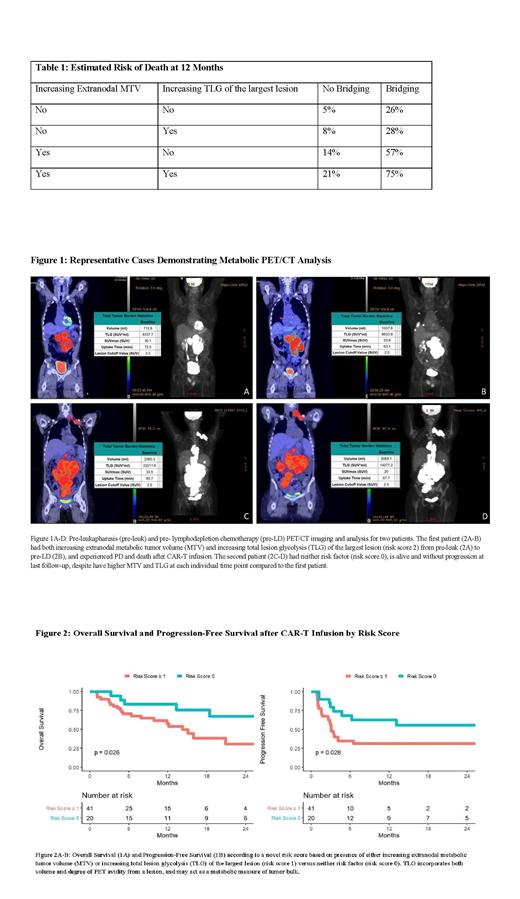Abstract
Purpose: Axicabtagene ciloleucel (axi-cel) is an anti-CD19 chimeric antigen receptor T-cell (CAR-T) therapy utilized for patients with non-Hodgkin lymphoma (NHL) refractory to at least 2 lines of therapy. F-18 fluorodeoxyglucose positron emission tomography/computed tomography (PET/CT) is used to evaluate disease extent prior to CAR-T infusion at two time points: pre-leukapheresis (pre-leuk) approximately 6 weeks prior to CAR-T infusion, and pre-lymphodepletion chemotherapy (pre-LD) approximately 1 week prior to CAR-T infusion. We hypothesized that PET/CT characteristics beyond Lugano criteria, such as metabolic tumor volume (MTV), total lesion glycolysis (TLG), SUV maximum (SUVMax), and changes in these parameters from pre-leuk to pre-LD, may predict for progressive disease (PD), death, and treatment toxicity after CAR-T infusion.
Methods: Patients with NHL who received axi-cel on a prospective registry at Mayo Clinic Rochester were included. Lesions on pre-leuk and pre-LD PET/CT scans were segmented with a fixed absolute SUVMax threshold of 2.5 using a semi-automated workflow (LesionID, MIM Software Inc.) with manual modification to exclude physiologic uptake as needed. MTV, TLG, SUVMax, number of lesions, and other lesion characteristics were assessed for each PET/CT, and changes from pre-leuk to pre-LD were calculated. Lesions were categorized as either nodal, spleen, bone, parenchymal (i.e. liver, lung), or soft tissue (i.e. subcutaneous, muscle), and MTV was calculated for each category. Univariate Cox modeling was used to associate relative and directional change in metabolic and volumetric PET/CT characteristics with PD and death, after adjusting for bridging therapy. LASSO method was used for multivariable model selection. Pre-LD PET/CT characteristics were also assessed for association with presence and duration of cytokine release syndrome (CRS), grade 3+ immune effector cell-associated neurotoxicity syndrome (ICANS), tocilizumab (toci) use, and corticosteroid use.
Results: From 2018-2020, axi-cel was delivered to 69 patients. Histology included diffuse large B-cell lymphoma (57%), transformed follicular lymphoma (23%), or high-grade lymphoma (19%). Pre-leuk and pre-LD PET/CT scans were performed a median of 46 days and 7 days prior to CAR-T infusion, respectively. Forty patients (58%) received bridging therapy between scans, including 9 (13%) receiving radiotherapy. At a median follow-up of 13 months, 39 (57%) had died and 46 (67%) had PD.
Sixty patients (87%) developed CRS following CAR-T infusion for a median duration of 5 days. Presence of pre-LD parenchymal disease was associated with longer duration CRS (p=0.032). Thirty-seven patients (54%) developed ICANS for a median duration of 4.5 days, including 12 (32%) with grade 3+ ICANS. Greater pre-LD total MTV was associated with higher risk of grade 3+ ICANS (p=0.042). Greater pre-LD SUVMax was associated with longer duration ICANS (p=0.032). Nineteen (28%) patients required toci. Greater pre-LD total MTV, SUVMax, TLG, and volume of the largest lesion were associated with increased use of toci (p<0.05 for all). Greater pre-LD total MTV and TLG of the largest lesion were associated with increased use of corticosteroid (p<0.05 for each).
While no individual pre-leuk or pre-LD PET/CT characteristics were associated with risk of PD or death, increases from pre-leuk to pre-LD in total MTV, total TLG, parenchymal MTV, and nodal MTV were associated with increased risk of PD (Figure 1). Similarly, increases from pre-leuk to pre-LD in parenchymal MTV, nodal MTV, TLG of the largest lesion, and total number of lesions were associated with increased risk of death (p<0.05 for all). LASSO analysis identified increasing extranodal MTV (≥25% increase) and increasing TLG of the largest lesion (≥10% increase) as strong predictors of death (AUC 0.74, Table 1). Kaplan-Meier plots were generated for overall and progression-free survival using these risk factors (Figure 2).
Additional patients and follow-up will be presented.
Conclusions: Patients with greater pre-LD MTV had higher risk of grade 3+ ICANS and use of toci or corticosteroids. Increasing metabolic disease burden during CAR-T manufacturing is associated with increased risk of PD and death. A two variable risk score using increasing extranodal disease and increasing TLG of the largest lesion may stratify prognosis prior to CAR-T and inform treatment paradigms.
Bennani: Verastem: Other: Advisory Board; Purdue Pharma: Other: Advisory Board; Daichii Sankyo Inc: Other: Advisory Board; Kyowa Kirin: Other: Advisory Board; Vividion: Other: Advisory Board; Kymera: Other: Advisory Board. Paludo: Karyopharm: Research Funding. Wang: Genentech: Research Funding; LOXO Oncology: Membership on an entity's Board of Directors or advisory committees, Research Funding; Eli Lilly: Membership on an entity's Board of Directors or advisory committees; Incyte: Membership on an entity's Board of Directors or advisory committees, Research Funding; InnoCare: Research Funding; Novartis: Research Funding; MorphoSys: Research Funding; TG Therapeutics: Membership on an entity's Board of Directors or advisory committees. Ansell: Bristol Myers Squibb, ADC Therapeutics, Seattle Genetics, Regeneron, Affimed, AI Therapeutics, Pfizer, Trillium and Takeda: Research Funding. Lin: Gamida Cell: Consultancy; Janssen: Consultancy, Research Funding; Legend: Consultancy; Novartis: Consultancy; Celgene: Consultancy, Research Funding; Sorrento: Consultancy; Bluebird Bio: Consultancy, Research Funding; Takeda: Research Funding; Kite, a Gilead Company: Consultancy, Research Funding; Merck: Research Funding; Vineti: Consultancy; Juno: Consultancy.


This feature is available to Subscribers Only
Sign In or Create an Account Close Modal